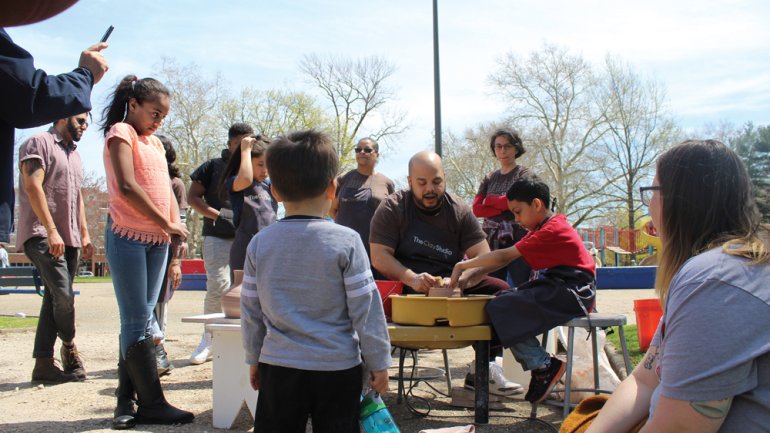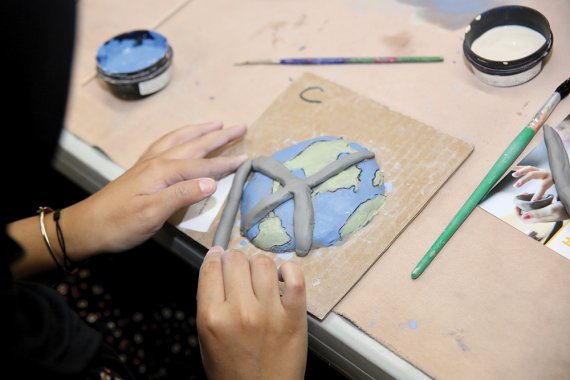Connect, Then Curate
Connect, Then Curate
I decided to study art history because I believe understanding art can help people understand what connects us all. I decided to become a curator to present art in a way that helps others see those connections. As curator of artistic programs at the Clay Studio in Philadelphia for four years, I’ve worked to make art relevant and accessible to as many people as possible.
A new project designed to build connections in the area where the Clay Studio will move in about a year has shown me how much I still have to learn, however. I expected to have some nice conversations with the residents of South Kensington, our new neighborhood. Instead, what has unfolded was completely different – and far more powerful than I could have imagined.
My first experience with the power of art to bring people together came in college when I was studying in Spain. I remember gazing up at cathedrals and ancient buildings, thunderstruck. I glimpsed, embedded in the architecture, the hopes and dreams of those who built them. Those buildings were as compelling as any document or decree.
So I studied art history, focusing on how works speak for peoples and cultures in history. At the American decorative arts department at the Philadelphia Museum of Art, I studied functional works such as chairs, vases, and teapots. I learned about the makers, patrons, and the cultures in which they functioned – how status was displayed, which objects were made, cherished, and saved for future generations. The connections between historical and contemporary objects began to fascinate me; I was never happier than when I discovered links between a carved mantel by Daniel Pabst in 1878 and one made by Wharton Esherick in 1935.
When I moved to the Clay Studio in 2015, I learned to make a new kind of curatorial connection – directly with the artists who make the sorts of objects I admire. I became a curator of art in a more immediate way, learning from the artists, discussing their work, their processes, their materials, their hopes and dreams. Curating programs and exhibitions with living, breathing people I knew forced me outside my comfort zone. But more challenges were around the corner.
A little more than a year ago, my colleague Josie Bockelman and I started talking about our forthcoming move to a rapidly gentrifying area and how we might become a welcome part of the neighborhood, rather than an interloper driving up rents and driving out longtime residents. We wanted to ask the neighbors how they’d like the Clay Studio to function in their community. We wanted the gallery space to be a place of sanctuary and inspiration, and the exhibition program to be welcoming and meaningful, especially for the people nearby. We wanted our neighbors to have a say in what we do – which was possible only if they felt comfortable walking in the door.
We developed a program called Clay & Conversations, asking for help from artists Roberto Lugo, who grew up in the neighborhood, and Jennie Shanker, who creates social engagement projects. We hired two community organizers to help us meet as many neighbors as possible. We organized four sessions, each with a ceramic project layered with a series of questions we hoped would spark conversation about how we could serve the community.
The surprises came fast and furious. Our initial plan was a kick-off party where we could introduce ourselves to lots of people as we made art and chatted. We quickly realized people were unlikely to engage before we went out and introduced ourselves and our project. Dozens of religious, civic, cultural, arts, garden, and school-based organizations were already there, doing great work. Who were we to suggest they wanted or needed us? So instead of a big party in September, we spent three months meeting with these groups, asking them to be part of our Clay & Conversations events.
We heard it would be hard just to get people to attend. Using grant money, we offered to pay people for their time and provided child care and food during the events. We were thrilled when people of all ages showed up. A group of about eight teenagers came to all four events – initially, they said, for the stipends, but they made art and contributed to the conversation as intently as anyone else. About 40 people attended each event, happy to have the chance to make something of their own, and determined to be heard. They included lifelong neighborhood residents, new arrivals from Puerto Rico after Hurricane Maria, members of the nearby Al Aqsa Islamic Society, artists who had moved to the area in recent years, and those ebullient teens.
Once people had clay in their hands, conversations blossomed. Intense discussions about art and life unfolded – though not in a tidy, cohesive way that was easy to capture. By the fourth event, we started placing staff and recorders among the participants to just listen.
That was my new curatorial lesson: Listen – and not just long enough to think of a response. Just be quiet and listen. Don’t try to steer the conversation where you think it should go; let it evolve on its own.
My background in curating and teaching makes it hard to listen quietly. But isn’t that one of the things missing today from American discourse? If there were more listening, perhaps there would be more understanding and less rancor.
Now, in the wake of our conversations, we have a new cohort of Clay Studio community members, new ambassadors. They form our neighbor advisory committee, which we didn’t know we needed until we did this project. What is exciting – and a little scary – is that our project hasn’t ended; it’s just beginning.
Today more than ever, we can all benefit from the power of art to bring people together. We need to work hard to make art relevant to new audiences. I am a curator in service to the art, the artists, the audiences, and the communities around me. I’m daunted by this changing role. At the same time, I can’t wait to keep listening, learning, and moving forward.
Clay & Conversations was funded by Pew Fellowships in the Arts.




